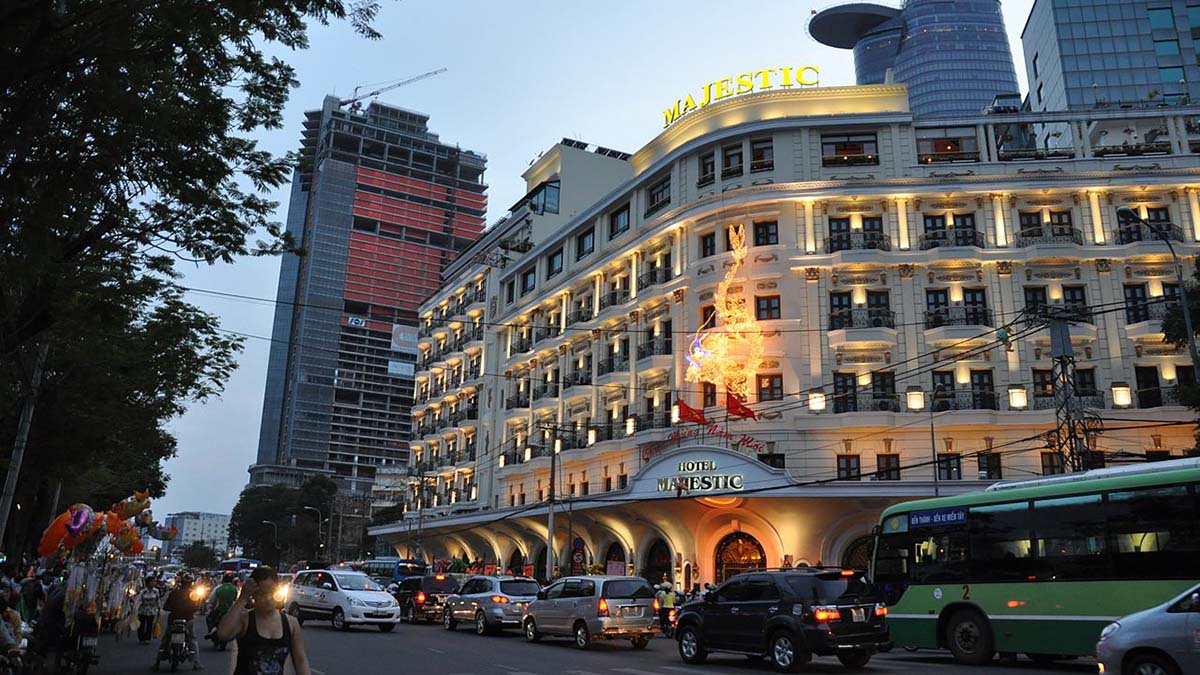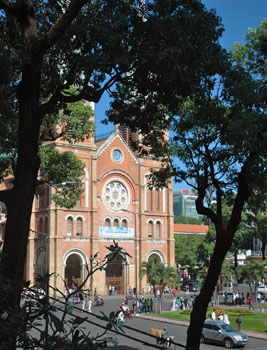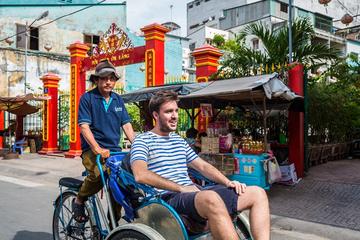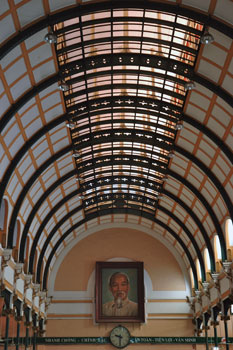
Vietnam
by Anne Harrison
Having spent a few years living in the city, Graham Greene’s The Quiet American is in many ways his homage to Saigon. Despite a somber tone colored by the knowledge of what is to come, Greene’s love of Saigon and her people shines throughout the novel.
The Majestic Hotel
The rooftop bar of the Majestic Hotel is a perfect place for sipping a cocktail as evening embraces Saigon. In The Quiet American the place overflowed at all hours of the day with American journalists. Close to the Saigon River, it proved a good spot to watch boat movements and garner knowledge from Vietnamese working in the area. Fowler met a fellow journalist here the night Pyle died.
With its colonial charm and retro style the hotel remains a city landmark, and the rooftop bar offers a quiet corner to overlook the Saigon River. The sounds of the traffic rushing along the streets are blown away by the evening breezes, which in turn bring some refreshing coolness after a day of the tropical heat.
Le Rue Catinat
After dinner I sat and waited for Pyle in my room over the Catinat.”
So opens The Quiet American. The Majestic Hotel stands on the corner of Duong Dong Khoi, formally the Rue Catinat brought so vividly brought to life by Greene. Especially down near the Saigon River, Duong Dong Khoi is a perfect place for an aimless stroll, whether browsing through local art works or loosing oneself in some of the best shopping in Saigon. French can still be heard in the occasional café or restaurant, and many women still wear traditional dress.
Up the street came the lovely fiat figures-the white silk trousers, the long tight jackets in pink and mauve patterns slit up the thigh: I watched them – with the nostalgia I knew I would feel when I had left these regions forever.”
The Rex Hotel
 Further along Duong Dong Khoi stands the Rex Hotel. Here the rooftop bar (complete with elephants) overlooks the heart of Saigon; perhaps this is why a bottle of champagne here comes with six waiters. The heavens of the wet season opened just as we sat down, so for an hour or so we had the place – plus waiters – to ourselves. After beginning life as a French garage, during the Vietnam War the Rex Hotel became home to the Press Corps, and probably the CIA. Now it is owned by the Communist Party.
Further along Duong Dong Khoi stands the Rex Hotel. Here the rooftop bar (complete with elephants) overlooks the heart of Saigon; perhaps this is why a bottle of champagne here comes with six waiters. The heavens of the wet season opened just as we sat down, so for an hour or so we had the place – plus waiters – to ourselves. After beginning life as a French garage, during the Vietnam War the Rex Hotel became home to the Press Corps, and probably the CIA. Now it is owned by the Communist Party.
Hotel Continental
I had seen him last September coming across the square towards the bar of the Continental.”
Fowler first spies Pyle at the Hotel Continental, and again this is where Pyle first meets Phuong. Greene lived here for two years (in room 210, a corner suite). The Hotel Continental is just up from the Rex Hotel on Le Loi St. Many journalists stayed here during the Vietnam War; wandering past the designer stores and into the chandeliered reception, I could understand why. The infamous bombing, where so many civilians died but Pyle took great care to ensure no Americans were injured, was close to the hotel, in the Place Gamier, just off the Rue Catinat.
Cholon
In Cholon you were in a different city where work seemed to be just beginning rather than petering out with the daylight.”
Cholon is the world’s largest Chinatown. By the time of The War Against The French (the period in which The Quiet American is set), the place had become a maze of opium dens and brothels. During the Vietnam War an uncountable number of US and foreign troops went AWOL here (many never seen again), and somewhere in the unnamed back streets Fowler met with Mr. Chou.
A Wooden Balcony
 A few tree-lined blocks to the north of the Rex Hotel, the Cathedral Notre Dame and the Central Post Office face one another across a small square. Although Fowler was dismissive of the style, the cathedral is quite delightful, with each stone shipped from Marseilles, and the stained glass from Chartres.
A few tree-lined blocks to the north of the Rex Hotel, the Cathedral Notre Dame and the Central Post Office face one another across a small square. Although Fowler was dismissive of the style, the cathedral is quite delightful, with each stone shipped from Marseilles, and the stained glass from Chartres.
I crossed to a café on the far side of the square, and was ushered up some rickety back stairs to a spacious wooden balcony overlooking the chaos of the cathedral square. Ceiling fans from the time of Indochine turned lazily above me. The Vietnamese rolls and papaya salad proved perfect in the heat.
Saigon is full of balconies such as this; Ho Chi Minh beckons be explored, but there is always a quiet place to sit, and ponder the past while time barely moves, drinking strong coffee from tiny cups while dreaming of writing a novel.
If You Go:
The Quiet American by Graeme Greene – essential reading
For dining, try:
♦ Temple Club (29-31 Ton That Thiep St) Once a pilgrim house, it now serves specialties from all over Vietnam
♦ Xu (75 Hai Ba Trung S)t An elegant restaurant near the river
♦ Ciao Bella (11 Dong Khoi St)
♦ Ngon Restaurant, (138 Nam Ky Khoi Nghia, opp Reunification Palace). Sit upstairs on the balcony and sample the local dishes
Don’t miss:
♦ Hoa Binh Noodle Shop or Peace Noodles (7 Lo Chinh Thang St) US troops ate pho downstairs, while upstairs the Viet Cong planned the Tet Offensive
♦ War Remnants Museum (28 Vo Van Tan St) Not for the faint-hearted. Upstairs is a spectacular, although graphic, photography exhibition.
♦ Reunification Palace (106 Nguyen Du St) The Fall of Saigon was cemented by tanks crashing through the gates; they are still on display. Within, little has changed since April 30, 1975

ESSENCE OF SAIGON – PAST AND PRESENT FROM HO CHI MINH CITY
About the author:
Anne Harrison lives with her husband, two children and numerous pets on the Central Coast, NSW. Her jobs include wife, mother, doctor, farmer and local witch doctor – covering anything from delivering alpacas to treating kids who have fallen head first into the washing machine. Her fiction has been published in Australian literary magazines, and has been placed in regional literary competitions. Her non-fiction has been published in medical and travel journals. Her ambition is to be 80 and happy. Her writings are available at anneharrison.com.au and anneharrison.hubpages.com.
Photo credits:
Majestic Hotel Saigon by trungydang / CC BY
All other photos are by Anne Harrison:
The touch of the French is everywhere
The rooftop bar at the Rex Hotel
Uncle Ho watches all
View of Notre Dame from a balcony
 After dinner I sat and waited for Pyle in my room over the Catinat.”
After dinner I sat and waited for Pyle in my room over the Catinat.” I had seen him last September coming across the square towards the bar of the Continental.”
I had seen him last September coming across the square towards the bar of the Continental.”


